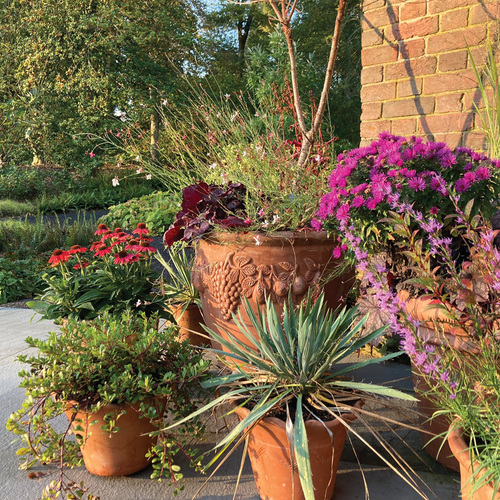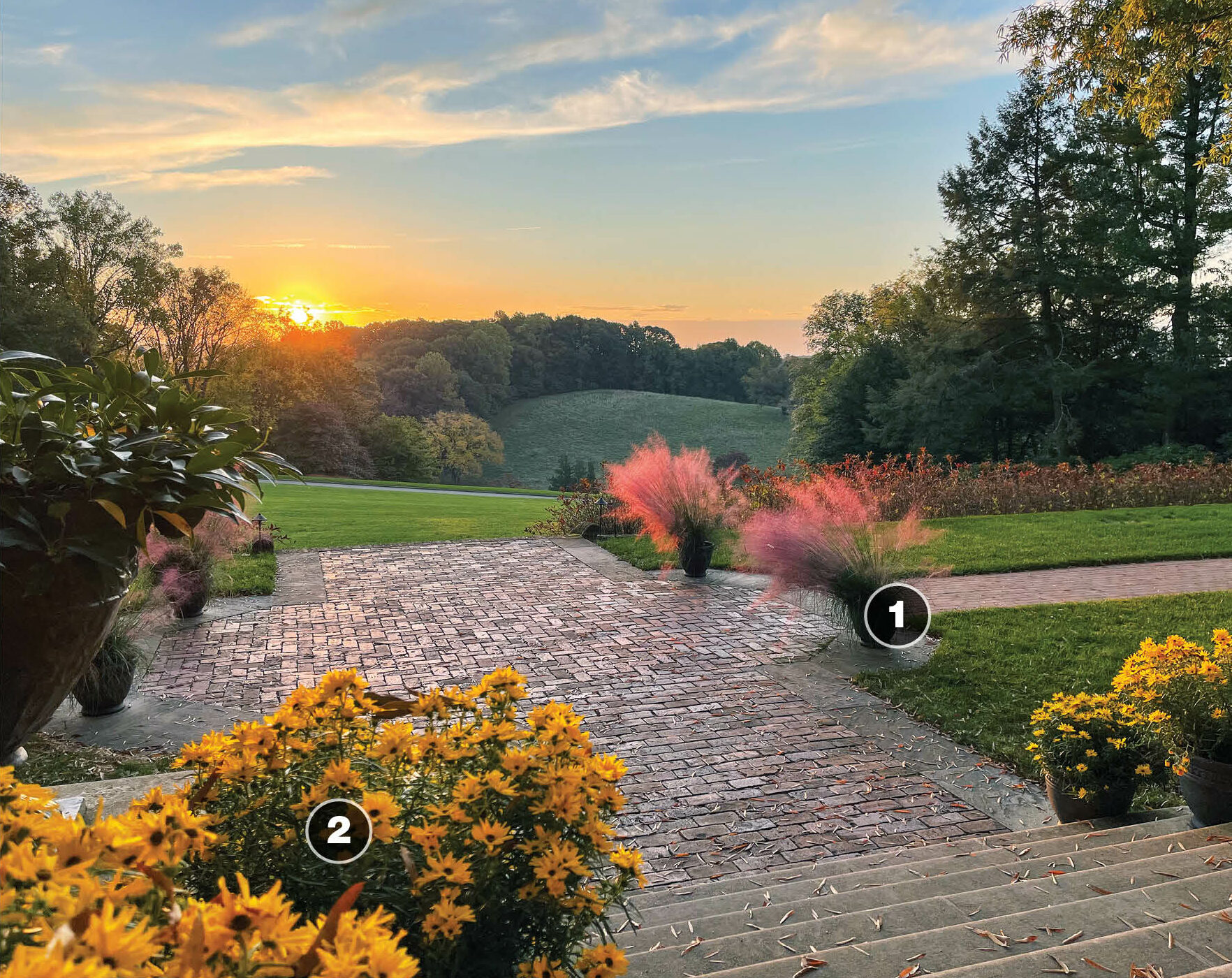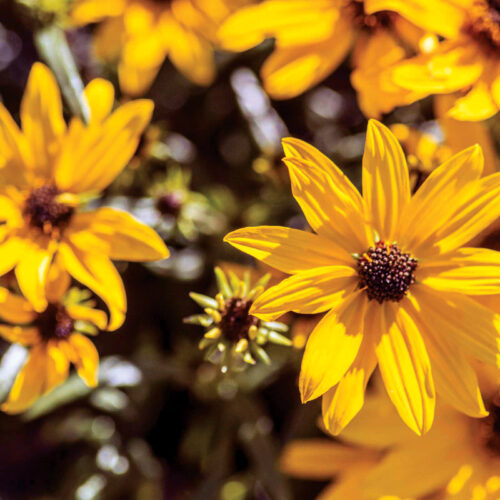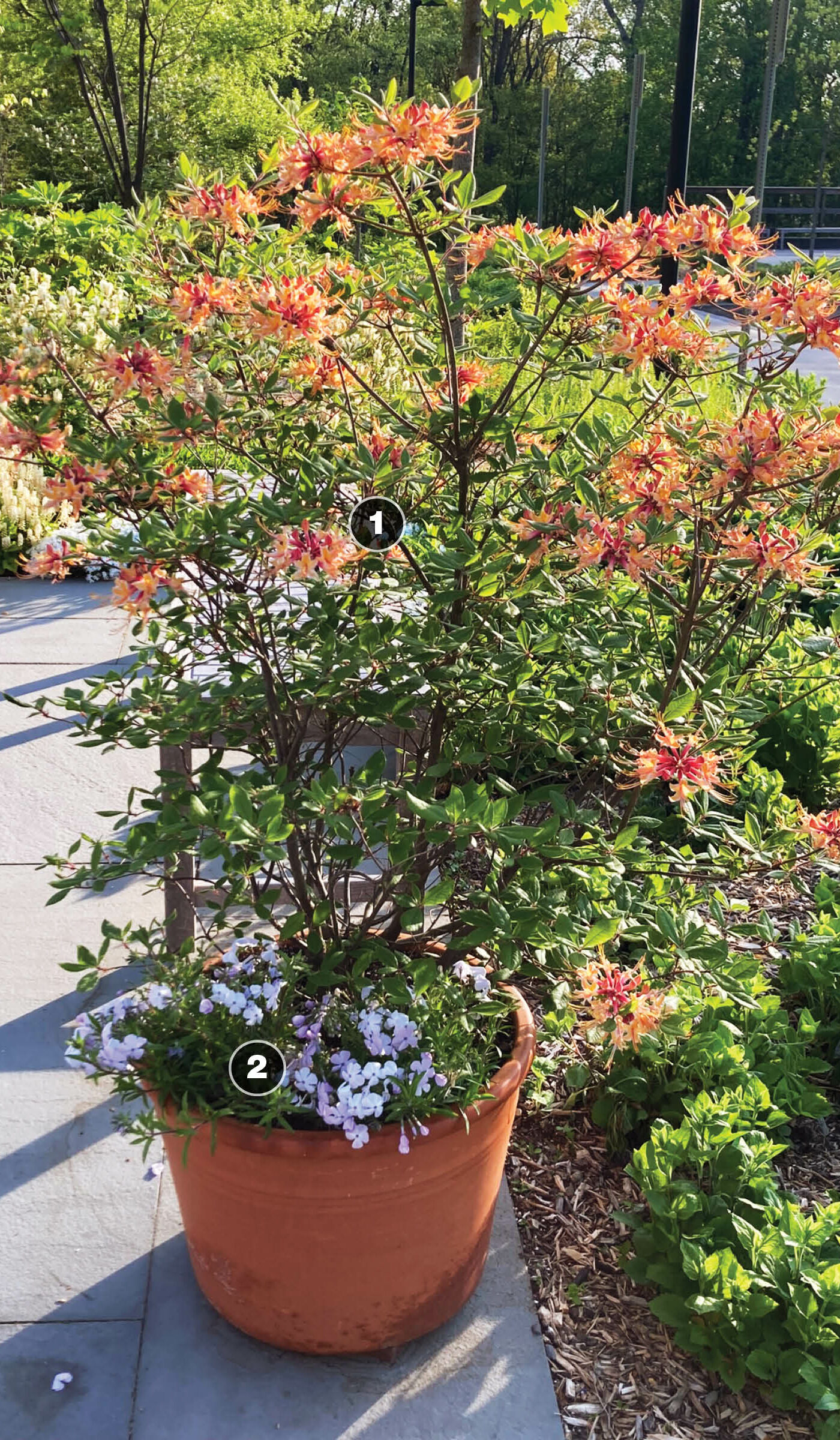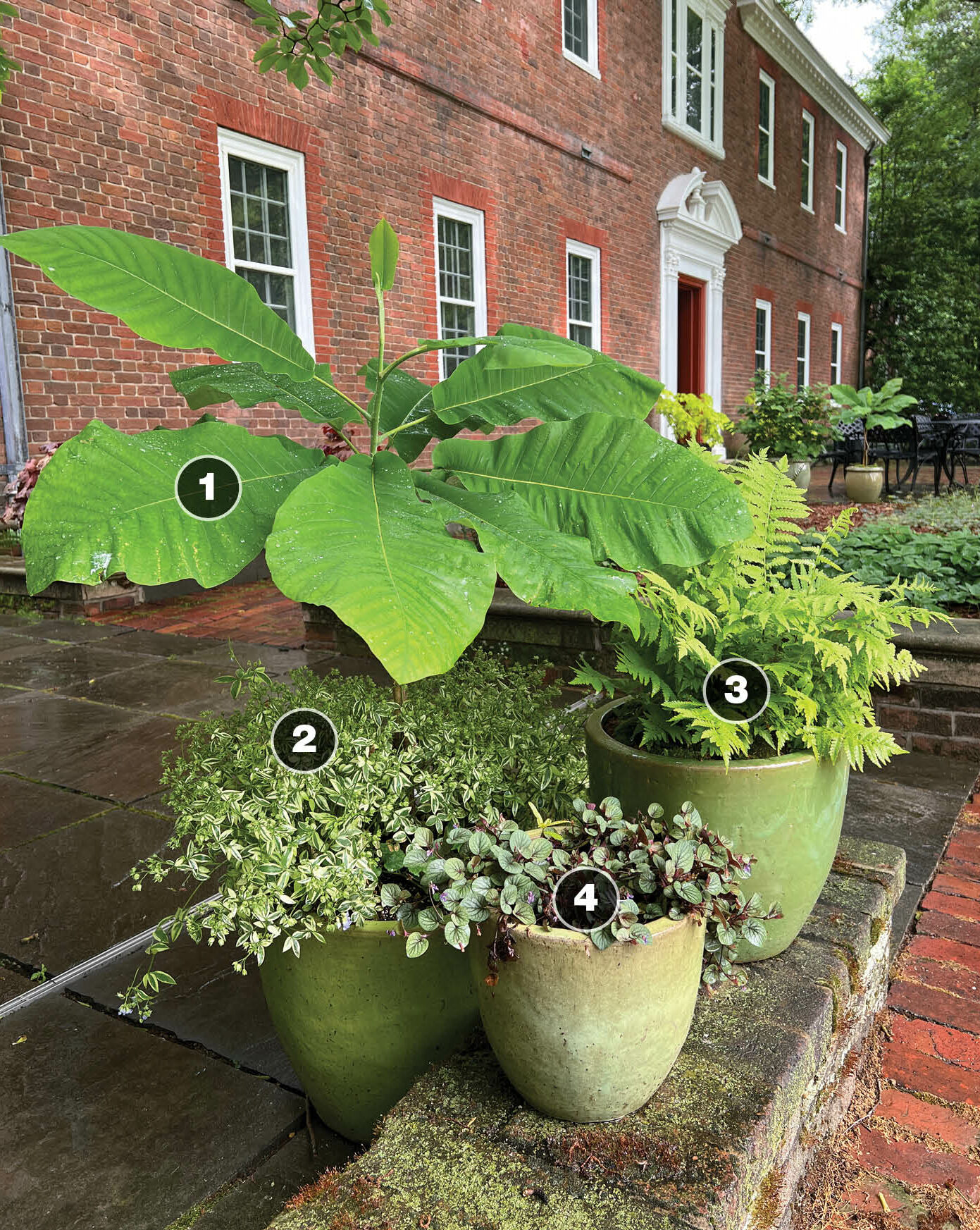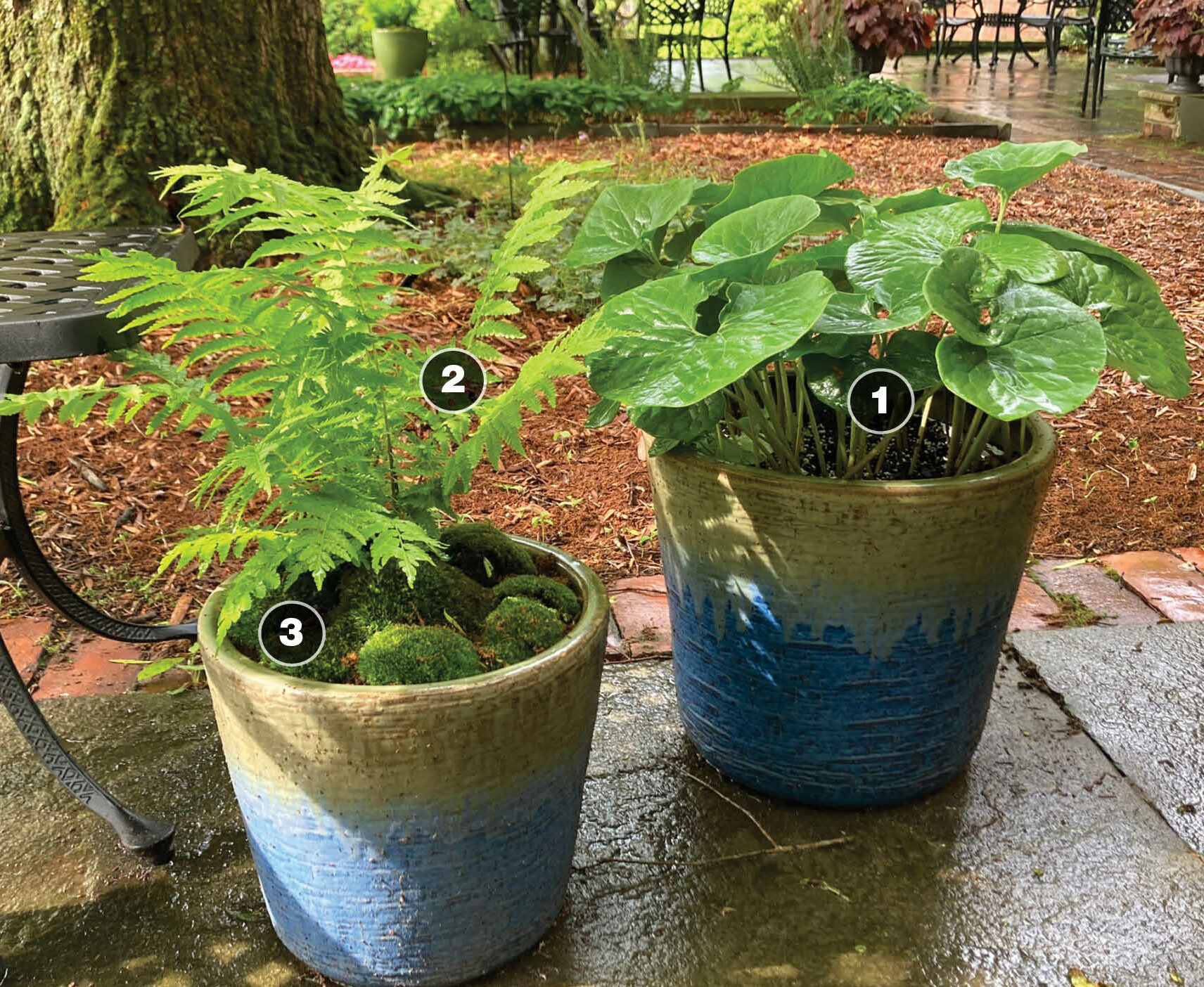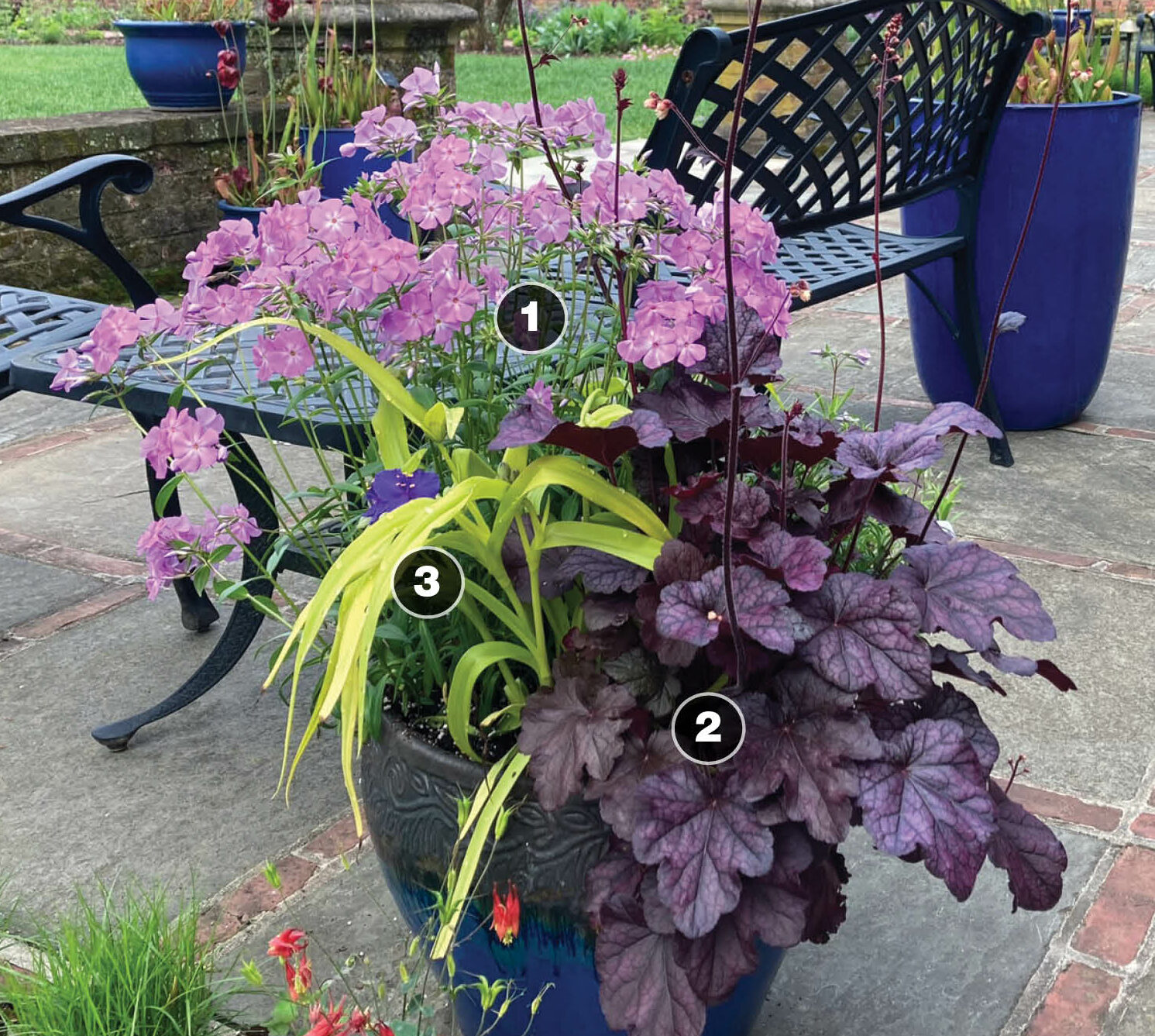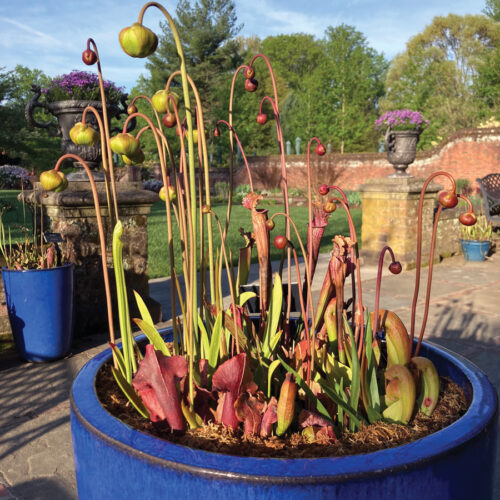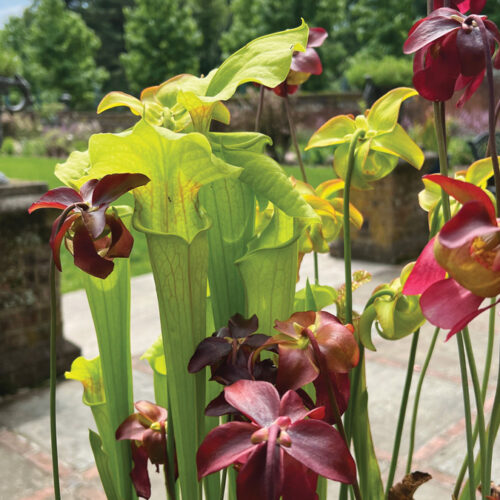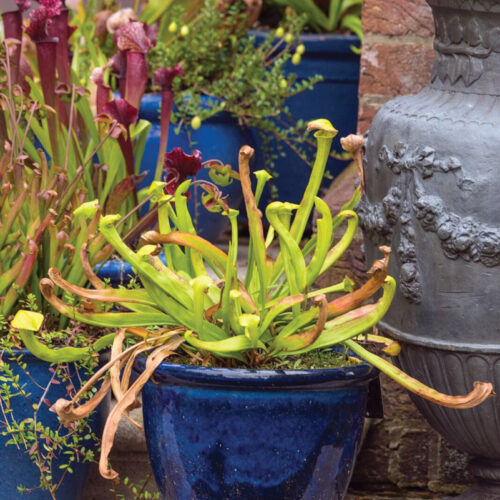Designing containers is a gratifying activity that will immediately transform any outdoor space, no matter the size. After joining the talented team at Mt. Cuba Center in Hockessin, Delaware, I was tasked with creating container displays with the caveat of using all native plants. This was a challenge I readily accepted, and over the past few seasons I have explored the versatility of local flora and shared the beautiful results with our visitors.
Container gardening with native plants allows anyone to support biodiversity and beautify an outdoor area, even if all you have is a front stoop in the city. If you do have a large garden with plenty of in-ground planting space, using natives in containers is a great way to highlight your favorites, or to grow species that require specialized soil conditions (see Pitcher Plants Grow Beautifully in Pots). I love bog plants, but the wooded hill I live on is certainly not boggy. Containers allow me to enjoy these wonderful perennials on my patio.
While many of the basics of container gardening are the same for native plants as they are for other ornamental species, there are some unique challenges. Most of the plants featured in this article are perennials; some grow slowly, and many won’t become worthy specimens in a single season.
This is where some basic plant knowledge comes in handy. I would never buy a gallon-size perennial like threadleaf bluestar (Amsonia hubrichtii, Zones 5–8), baptisia (Baptisia spp. and cvs., Zones 4–8), or Culver’s root (Veronicastrum spp. and cvs., Zones 3–8) and expect it to become a robust show-stopper in just one season. Instead, I shop for plants that will fill out much faster, like bee balm (Monarda spp. and cvs., Zones 4–9), coreopsis (Coreopsis spp. and cvs., Zones 3–9), or hibiscus (Hibiscus spp. and cvs., Zones 4–11).
Another challenge is the fleeting nature of many perennial flowers. To address this, I look for plants that have a longer bloom time, an interesting seed structure, pleasing foliage, or a combination of all three. For selections that lack these characteristics, I just plan on switching out a single plant (or sometimes the entire display) for something else that looks great in each season. The following native plant container designs are some favorites that have gotten a positive response from Mt. Cuba Center’s visitors over the past few years.
Gather star performers in a sunny spot
Container groupings are an easy way to make an impressive display that changes with the seasons. Some plants in this group can be featured from spring through fall, while other containers can be swapped in and out to create seasonal magic. Even in mixed containers, a plant that is losing its aesthetic appeal can quickly be replaced with another (inset). Combine multiple textures and plant forms for an eye-catching array that promotes your love of native plants.
1. ‘Excalibur’ yucca (Yucca filamentosa ‘Excalibur’, Zones 4–10)
2. ‘Pink Crush’ New England aster (Aster novae-angliae ‘Pink Crush’, Zones 3–8)
3. Dwarf blazing star (Liatris microcephala, Zones 6–9)
4. Kismet® Intense Orange coneflower (Echinacea ‘TNECHKIO’, Zones 4–9)
5. Common bearberry (Arctostaphylos uva-ursi, Zones 2–7)
6. ‘Palace Purple’ heuchera (Heuchera ‘Palace Purple’, Zones 4–9)
7. ‘Siskiyou Pink’ gaura (Oenothera lindheimeri ‘Siskiyou Pink’, Zones 5–9)
Simplicity rules
|
|
The matching containers that line the sides of this wide staircase are changed out frequently, so the plants on display always look their best. At the foot of the stairs, another set of containers marks the intersection of a path and patio. These guideposts are beautiful in their own right and also encourage guests to pause and admire the view over the hills of the Delaware Piedmont.
1. Pink muhly grass (Muhlenbergia capillaris, Zones 5–9)
2. ‘Autumn Gold’ willow-leaved sunflower (Helianthus salicifolius ‘Autumn Gold’, Zones 5–9)
Plan ahead for a spectacular spring show
‘Millie Mac’ is a deciduous azalea that supplies glowing sunrise hues in mid- to late spring, just as it is beginning to leaf out. Coral-tinged flower buds unfurl into fragrant blooms that range from yellow to orange. Peaking at the same time, the violet-blue tints of ‘Woodlander Lilac’ phlox provide a cool-color counterpoint at ground level. These two woodland beauties appreciate consistent moisture and a little shade, but both are surprisingly adaptable to warmer, sunnier conditions. A pot like this can easily be brought out into a prominent location during bloom time and moved to a shadier, cooler locale later in summer.
1. ‘Millie Mac’ azalea (Rhododendron austrinum ‘Millie Mac’, Zones 6–9)
2. ‘Woodlander Lilac’ phlox (Phlox ‘Woodlander Lilac’, Zones 4–9)
Got shade? Get dramatic with foliage
You don’t often see plants like Ashe’s magnolia or ostrich fern in pots, but these beauties pack as much punch as anything you could find in the tropical section of the nursery. Flanked by a variegated Jacob’s ladder and a silver-leaved violet, this combo is a fetching focal point that looks great for months on end.
1. Ashe’s magnolia (Magnolia ashei,
Zones 6–9)
2. ‘Stairway to Heaven’ Jacob’s ladder (Polemonium reptans ‘Stairway to Heaven’, Zones 3–8)
3. Ostrich fern (Matteuccia struthiopteris, Zones 3–7)
4. ‘Silver Gem’ prostrate blue violet(Viola walteri ‘Silver Gem’, Zones 5–9)
For a peaceful, meditative effect, highlight one plant per pot
|
| Tip | Mulch with mossNative moss adds a little charm, and no one wants to look at potting mix. Protect your local ecosystem by sourcing your moss from a grower rather than collecting it from the wild. |
Simplicity is pleasing to the eye, which is why we increasingly favor containers featuring a single native plant. This pair of pots sited in full shade hold lush green foliage that evokes a sense of calm and relaxation, just like a woodland walk would do.
1. Wild ginger (Asarum canadense, Zones 4–6)
2. Ostrich fern
3. Pincushion moss (Leucobryum glaucum, Zones 3–9)
|
| Tip | Control soil fertility A potting mix without any added fertilizer is best for most of our native species, which tend to have low nutrient requirements. Instead, add a bit of compost, keeping the ratio to no more than one-fourth of the mix. At Mt. Cuba Center, we apply a balanced organic liquid fertilizer biweekly, after watering. This approach utilizes sustainable products and gives our staff full control over the quantity and quality of nutrients available to the plants. |
Set the mood with shimmering color
Well-designed containers can define a space, add seasonal excitement, or frame a view. These eye-catching blue containers flank the entry and exit of a paved terrace, creating a threshold that signals a change in a guest’s garden journey. As the pathway they’ve been following transitions to a furnished garden room, the containers serve as a subtle suggestion to pause, have a seat, and take in the garden beyond.
1. ‘Morris Berd’ smooth phlox (Phlox glaberrima ‘Morris Berd’, Zones 3–8)
2. ‘Palace Purple’ heuchera
3. ‘Sweet Kate’ spiderwort (Tradescantia ‘Sweet Kate’, Zones 4–9)
| HOW-TO |
Pitcher plants grow beautifully in pots
We display native pitcher plants (Sarracenia spp. and cvs., Zones 6–9) in containers, where they are surprisingly easy to grow and offer a full season of interest and beauty. These aesthetic oddities have spring flower buds like hanging orbs, which unfold into structures shaped like showerheads. Flowering is followed by a flush of foliar growth in a multitude of colors with gorgeous venation. Seeing their unique adaptations up close always fascinates visitors, who understandably assume that these exotic-looking beauties are difficult to grow. But creating a stunning container display with pitcher plants is actually a breeze. Here’s how it is done.
- Use a sturdy container and cover the hole with a stone or piece of terra-cotta so that it will drain slowly.
- Mix an equal amount of peat moss or coir with sand for the potting media.
- Don’t fertilize or add compost, but do make sure the potting mix stays moist.
- Don’t worry about maintenance, which is minimal. Simply cut back pitchers throughout the season as they turn brown.
- Overwinter containers in a cool space where they will not freeze (a garage or basement would be great).
- Divide and re-pot pitcher plants once every two years.
Michael Strengari is senior horticulturist at Mt. Cuba Center in Hockessin, Delaware.
Fine Gardening Recommended Products
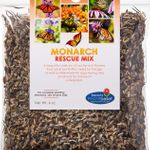
Monarch Butterfly Rescue Wildflower Seeds 4 oz.
Fine Gardening receives a commission for items purchased through links on this site, including Amazon Associates and other affiliate advertising programs.
HIGH QUALITY SEEDS and EXPERT GUIDANCE: Experience the quality seed difference. We are committed to providing the highest quality, open-pollinated, non-GMO/non-GE seeds to our customers, guaranteed. A trusted source of high quality seeds since 1985. ATTRACT MORE MONARCHS: We know seeds and we know pollinators! Our expertly crafted botanical garden seed mixes contain a wide variety of both perennials and annuals that are specifically designed to attract pollinators. Attract more Monarchs and Butterflies in general. Gardener tested, pollinator approved! All Of Our Wildflower Varieties Are 100% Pure Seed, They come with complete planting instructions. Compare and see the quality value. This Wildflower Seed Mix will make the perfect gift for those gardeners in your life.

A.M. Leonard Deluxe Soil Knife & Leather Sheath Combo
Fine Gardening receives a commission for items purchased through links on this site, including Amazon Associates and other affiliate advertising programs.
MULTITASKING DUAL EDGES: a deep serrated edge and a tapered slicing edge ideal for tough or delicate cuts. DURABLE 6-inch stainless steel blade withstands 300 lbs of pressure. TWINE CUTTING NOTCH, DEPTH GAUGE MARKINGS & spear point – no need to switch tools when using this garden knife. LEATHER SHEATH: heavy duty, protective, clip on sheath to keep your knife convenient and secure. LIFETIME WARRANTY.
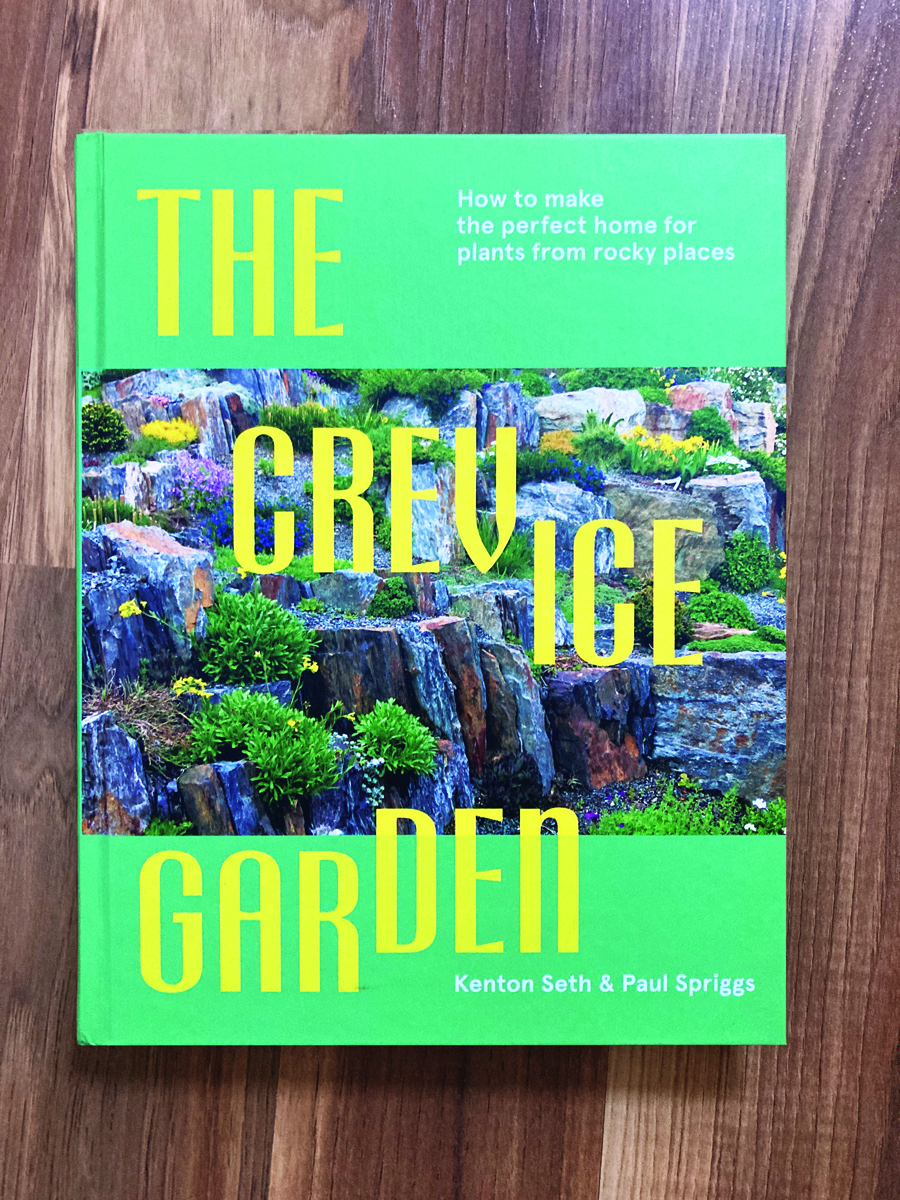
The Crevice Garden: How to make the perfect home for plants from rocky places
Fine Gardening receives a commission for items purchased through links on this site, including Amazon Associates and other affiliate advertising programs.
A crevice garden replicates the environmental conditions of mountain tops, deserts, coastlines, and other exposed or rocky places on earth. These striking garden features provide perfect conditions for the plants native to these far-off places, bringing the cultivation of these precious gems within everybody’s reach.

